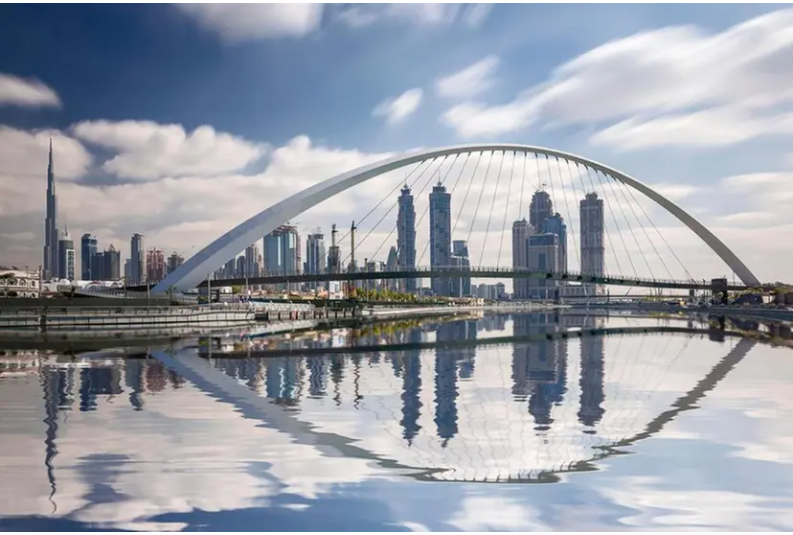BUSINESS & ECONOMY
Legitimacy of Values during Climate Change
Published
2 years agoon
By
Editor
Post-industrial and neo-technological societies have rigorously separated the stories of cultural values and those of the earth’s nature and climate. Human civilizations have been fully dependent on the wilderness of nature and the particularities of climate for their survival and success for millennia. It is understandable that this decoupling in the 20’th century was inevitably perceived as a desirable outcome. For some years now these two stories are coming together once again meshed by the increased unpredictability and volatility of extreme climate events and their recorded and proven impacts on society at large. They are coming together at a time of repeated signs of perceived and real social and economic fragility, which if not absorbed and equitably remediated may trigger systemic changes. Many complex constructs are used to define systemic change. Among them are some traditional ones of economic shock and of increased volatilities in financial markets. More tangible and physical constructs appeal to unique economic issue such as of the widening gap in insurance coverage. Most recently some modern constructs of climate inequality bring together the stories of nature and social issues on the same conceptual and policy plane. All of these constructs and stories contain an element of social fragility. These formalized concepts are part of a language, which is built to abstract from reality and to adapt to academic, scientific and policy research and its consecutive conversations. Yet, these are not only theoretical constructs, but also tangible stories describing social catastrophes already experienced in recent historical realities. The misfortunes of climate change, pandemic and armed conflict emphasize the fragility of our modern society. These experiences of stress, destruction and loss have vividly erased the distinction between the economic and political impact of natural, health and man-made catastrophes and the sheer human disaster and suffering. They have also raised the need for an immediate examination of the sustainability and legitimacy of many current cultural norms. This process of examination is intended to lead to a proposition that for a cultural norm to be legitimate it must be found socially sustainable and socially resilient. The resilience of a social system becomes a requirement for its own legitimacy. It is well understood and accepted that a social order must protect the life, property and essential liberties of the people who belong to it to be found legitimate. The cultural definition of social resilience and sustainability may vary to some degree across geographical regions and political systems but there is some broad consensus. There is even less divergence in understanding that social resilience in itself becomes the indispensable foundation for systemic legitimacy.
Social resilience for the purpose of this analysis is defined as the ability of a society to adapt and absorb large shocks and externalities caused by excess climate volatility and unpredictability. In general resilience is achieved through preparation for extreme, highly unfavorable, and catastrophic outcomes oftentimes cascading through all nodes of the systemic structure. Systemic architects build tiers of reserves and pockets of conserved energy, which are designed to absorb catastrophic shocks. Still systemic reserves and endurance are an exhaustible resource. Once such resources are depleted, catastrophic shocks through a process of network contagion may have deep cascading effects into social and economic layers, previously considered riskless. Such impacts may lead to systemic collapse and full or partial reorganization of many systemic nodes and layers. The processes of collapse and reorganization may be gradual and of evolutionary nature, but it may also be of a sudden and catastrophic nature. In both cases social resilience towards environmental and climate shocks and catastrophes can never be infinite. Remediating the impacts of climate and natural disasters in an equitable manner becomes a common measure of societal endurance. The various degrees of this systemic ability to provide equitable remediation and then recovery from a catastrophic shock have become a comparative metric of systemic resilience. Systemic stability thus becomes a measure of the veracity of social and political systems. Once systemic and social resilience is brought into macro-economic and macro-financial policy discussions, there grows a need for providing a transition and mapping in definitions and measures. This is not a transition and remapping of exclusively and purely technical definitions. This transition is also about a redefinition of a cultural measure – being a measure of value, which must be associated with the legitimacy of current economic and political enterprises. Furthermore, this transition must be about providing information and a degree of evaluation of the durability and longevity of its underlining social establishment. A cultural measure thus must contain valued societal information. This transition is also required to both stimulate and defend the need for a revision of cultural values in such manner that they unquestionably enhance systemic legitimacy. This new dominion of cultural values must contribute to systemic sustainability and thus must have systemic resilience at its core to be legitimate.
The process of economic globalization at a time of lower climate predictability, at a time of growing volatility in extreme natural catastrophes provides this very ground necessary to intertwine the stories of nature and social values. These premises allow an examination of a twofold need for both redefinition of values and for reclaimed systemic legitimacy. The foundations of the current version of the global economy can be traced back to about forty years. The first phase of globalization is about economic growth and accumulation of wealth. It is about the advancement of technological knowledge and building of interconnectivity among regional and national financial, trade and economic systems. These were years of continuous economic growth. They fostered the progress of the established model and the acceptance of its very outcomes. The economic statistics of the period were convincingly reinforcing the intellectual and technical analysis. Absolute and per capita gross domestic product metrics were rapidly raising. The proverbial tide was lifting all boats – big and small. GDP growth as a measure of the economic effectiveness of the system assumed unlimited and boundaryless resources. This economic success blunted our intuition accumulated from historical experience and our historical cognition gained from studying natural sciences and mathematics. These exact sciences have always maintained that every physical system and every physical process have boundary conditions and limitations. Once these boundary conditions are breached, otherwise and previously stable systems and processes collapse or may perform in chaotic and shockingly unrecognizable manner. From first principles of system’s theory, it is established that breaking through one boundary condition may be sufficient to shock a system and throw it into a state of chaos or collapse. In the last two decades we have broken through three such boundaries of stability – these of efficient markets, of the resilience of global health, and of the predictability of the earth’s climate as a vital natural resource. The breach and exhaustion of these limits reveals previously hidden costs of our economic model at a time of disruption and instability. At present there is no recognizable political system, which can survive, let alone succeed without economic growth being its primary objective. Furthermore, for three centuries, since the onset of the industrial revolutions, the expansion and intensity of our drive towards growth and wealth rendered to second order the values of environmental protection and maintaining the stability and predictability of the earth’s climate.
In this inevitable entanglement of risk factors, cultural values and measures of systemic legitimacy, there is a critical component, which is rarely discussed. This is the impact of moral hazard. The scenario of its emergence has been experienced previously in other settings and can be foreseen with certainty. The measurements of disaster and shock in health and economic systems and their contagion effects upon social fragility have been observed and presented to the public discourse. Counter measures of remediation are also defined and refined. Both types of measures are examined and validated by technical and political authorities and thus may become reflected in established policy. During this process there is an element of moral hazard of such policy innovation being implemented only in physical, statistical, economic and health metrics but not yet becoming deeply embedded in cultural values, that are well accepted in society. It is still by no means necessary that this process of exploration, investigation, and policy definition in itself will lead to a transition in cultural values. There is no mandatory social provision or entity that requires this transition to take place or makes it inevitable. Such a transition to a new set of cultural values cannot be mandated. It cannot be enforced. If moral hazard is allowed to become the preponderant ethical concern in the process of value transition, itself accelerated by rapid systemic change, then systemic legitimacy will be endangered. Thus, the only mechanism which remains to facilitate a transition to a new set of moral values is a widely accepted necessity at all societal levels to ensure the survival of systemic legitimacy.
The development of the global economic system is one process where an emerging transition and mapping of new cultural values may express itself for observation. A transition and remapping of value must then overwhelm all other considerations to become embedded in the values representing the second phase of globalization. The only intellectual force which is capable of accomplishing this drive is the search for systemic survival and legitimacy. By this logic the second phase of globalization should establish itself to be about managing common and existential threats from natural catastrophes and extreme climate events as much as it would be about economic growth and wealth accumulation. A new global economic system is thus deemed timely for design. This one must balance twin objectives – growth and wealth creation on one side with sustainability and preservation of natural, human and climate resources on the other. The importance of balance among these two objectives is undisputable. However, the instruments of balance are far from being yet available. The current economic model is fully and well equipped with all the instruments and techniques of causing a profound disbalance. To pursue the objective of economic growth and accumulation of wealth tools and frameworks refined over hundreds and in many cases over thousands of years are well established. These are goods, commodities and financial markets with their domestic and international trade agreements and their investment and growth policies. The mastery of economic growth presents a danger of allowing self-deception to grow in society of its mastery over nature. The lessons learned every day from climate science reveal elemental forces that can bring about a redefinition of the path of civilization. These same earth and physical sciences show society with every newly compiled scientific report that the story of growing climate unpredictability and its adverse outcome of extreme catastrophic events is also a human story. Balance rather than mastery should be the only sustainable and legitimate principle in the further development and unfolding of this story. To pursue a balance with a new set of values, which center on preserving natural and climate resources, at present society is inadequately, and better still, quite ill equipped for the task. We are unequally equipped to pursue balance and hence the most likely outcome is disbalance and inequality of outcomes. The hard task has become not whether and when but how to find with urgency a new set of moral values which will underwrite this story of balance and stability.
Our current civilization and its economic model have honed and perfected instruments and processes for economic growth for many years. This drive to succeed economically to accumulate wealth has become genetically engrained in many who subscribe to the values of contemporary civilization. It has become a part of the human story. So far this has been a tremendously positive story of our civilization. Now a time has come, where a natural resource upon which this drive depends so thoroughly and unequivocally, namely the predictability of earth’s climate, has run short of its previously unquestioned stability. There are no social preparations for this turn of things. A comparison is highly illustrative between the enormous accumulation of tools, treaties, international and state structures on trade, development, and investment to what we have to manage and balance a newly defined instability. The modern pace of knowledge creation and technological development allows states, societies in general, to quickly build a comparable machinery of institutions, treaties, and processes for managing this risk, and to ensure sustainability and predictability of this natural resource of earth’s climate. This can be done in a relatively short period of time.
The essence of these two human activities – the pursuit of economic growth and the preservation of a fundamental natural resource, defined as the stability and predictability of climate can no longer be mutually exclusive. Societies have trained themselves to succeed in the former for many generations and yet they are only in the first generation to face the need to be equally effective in the latter. The time of a single generation must be sufficient to raise a civilization to the magnitude of this task. This amounts to a shift in cultural values. The definition of economic success must and will continue to encompass growth and wealth accumulation. An updated and modern definition must balance these with environmental sustainability, personal and public health, and general well-being. Market and economic stability and success are no longer sufficient to define systemic success. This transition of values must hold true at the level of the corporation, the public sector, an administrative region and even the sovereign state and the international institution. The interconnections between the lack of climate predictability, excess climate volatility and the emergence of new frameworks of values in economic and political activity are not straightforward and linear. Herein the technical definition and social perceptions of the concept of systemic stability are changing. The new and emerging technical definition implies moral sentiment. Work aimed at accomplishing the definition of systemic success is a work to gain ownership of the present and the future. The criteria of systemic stability now become a set of shared values and shared technical definitions. While technical definitions are much easier to change values alter through a much slower process of evolution, transition, and remapping. Organizations, regions, states which can provide this desired stability will be defined and accepted as successful both in economic and social terms. The alternative will be considered systemic failures. If an institution cannot be the source of its own stability and sustainability, then it is by all laws of nature and economics a failed entity.
The mechanics of markets, trade, and investment work without the intervention of a hegemon. Nonetheless they tend to have self-correction and recovery memories and capabilities and thus provide their own state of stability. However, at present, both cultural traditions and market frameworks are missing a moral sentiment needed for fostering sustainability and recovery of a natural resource as vital as climate stability and predictability. Only until recently, this resource was deemed to be boundless. The transition and remapping of values will require that now this resource is seen as a basic tenet of the legitimacy of social cultures. In a broader perspective it is evident that climate issues are local, institutional, and individual and they impact communities and organizations differently. Thus, for a transition to a new set of cultural values to take place the work and preparations needs to take priority. The lack of a globally accepted framework and a hegemonic plan of action with an existing philosophical current deeply vested in resolving these challenges emphasizes the need for collaboration. Resolving and managing a global crisis of an essential natural resource without core and periphery, without clearly defined geographical and social hierarchies is a collaborative effort of the largest possible scale. A framework of collaboration will withstand the pressures of chaotic action born from the lack of rigid contractual frameworks. This collaboration is vitally needed at all systemic levels – the state and region, the corporation, university, and the non-governmental, civic, and military institutions.
In a new regime of torrential change in a global system lacking a pronounced hegemon, agreement is unsurprisingly hard on who should bear the cost of action. In such a circumstance there simply cannot be an authoritative prescription of who should define the mitigation of risk and its consequences. On the level of cultural and social values there cannot be an authority which demands the right and the obligation to change a person’s or a social group’s way of life. Hence it is essential to treat global climate risk as a unifying concept of common human heritage. The concept must be allowed to evolve into an item of collaboration and to allow various degrees of its adoption. Out of this collaborative effort climate and health stability fostering services would be generated and simultaneously would become sources of newly created economic and social wealth. This new kind of wealth creation is driven by both the self-interest of all actors, and by the process of collaboration and collective understanding of the vital challenges at hand. Systemic stability, which includes climate and health factors relies for its success and endurance on this accumulation of self-interest and collective interest. At the human level this is an opportunity to connect the story of society and its desire for growth and its hidden pitfalls with the story of the tremendous power of the earth’s nature and its climate. Particularly in the advanced post-industrial and neo-technological societies these stories have been kept far apart for far too long. The excess volatility of climate, the accumulation of knowledge on the impacts of climate’s unpredictability are creating a societal opportunity to rethink these two stories. We must weave them together again, as our ancestors have always done this in the past.
Related
You may like
-


WEF and UN-Habitat Join Forces to Unlock Critical Investment in Cities through Public-Private Collaboration
-


5 ways countries can adapt to the climate crisis
-


The Development of Artificial Intelligence in China: Conclusions
-


Four ways the planetary crisis is impacting mental health
-


New European Bauhaus under Cohesion Policy: €50 million call for innovative projects in cities
-


The Development of Artificial Intelligence in China: Investment and attention to production
BUSINESS & ECONOMY
CFA Franc: is the Time up for the Colonial Currency?
Published
2 weeks agoon
April 9, 2024By
Editor
By Kai Koddenbrock
At no point in history has the CFA franc – the name of a colonial currency used in west and central African countries belonging to the franc zone – been closer to its demise. Senegal has overwhelmingly voted for leftwing Pastef candidate Bassirou Diomaye Faye (and his former party leader Ousmane Sonko) while the coup governments in Mali, Burkina Faso and Niger have been talking about leaving the CFA franc for some time.
Senegal under outgoing president Macky Sall was a pillar of the longstanding French attempt to remain influential among its former colonies, often named “Francafrique”. Now newly elected Faye, under the moniker of “Left Panafricanism”, has vowed to make his country more sovereign in food, energy and finance. Never before have four west African governments, including one of the regional leaders, Senegal, been simultaneously eager and ready to get out of the neo-colonial stranglehold of the CFA franc. The CFA franc zone was founded by then colonial power France after the second world war. Its aim was to ensure a continuously cheap influx of resources into France.
The zone is divided into two. The west African CFA franc zone has eight members: Mali, Niger, Burkina Faso, Senegal, Côte d’Ivoire, Benin, Togo and Guinea-Bissau. The central African zone has six: Cameroon, Gabon, Republic of Congo, Central African Republic, Chad and Equatorial Guinea.
Popular mobilisation against the currency has been intense in recent years in west Africa. This led to cosmetic changes to the currency arrangements. For example in 2019, French president Emmanuel Macron and the sitting president of Côte d’Ivoire, Alassane Ouattara, announced the withdrawal of French staff from some of the regional central bank’s decision-making bodies. They also waived the requirement – much maligned on the continent – to store 50% of all reserves in Paris as a guarantee to the former colonial power that they wouldn’t be wasted on irresponsible fiscal expansion. Overall, however, the CFA franc has remained more or less the same and France has not been willing to leave the arrangement of its own accord. The old colonial attachment and supposed developmental benevolence has carried the day.
But the conditions for major change are in place. The Alliance of Sahel States between the junta-led governments of Mali, Burkina Faso and Niger has stated its intention to introduce the “Sahel” as a new regional currency. Whether this initiative – and the Senegalese plan for a national currency – will amount to a full break-up of the CFA franc zone and its terminal decline will depend on how well they plan and execute the transition to several new currencies or a new one without any French involvement.
A hard road ahead
Historically, as shown by Fanny Pigeaud and Ndongo Sylla in their book Africa’s Last Colonial Currency: The CFA Franc Story, serious attempts at leaving the CFA franc since its inception in 1948 have been sabotaged by France. For example, Guinea was flooded by counterfeit banknotes when it left the CFA franc in the 1960s. Mali was put under pressure to rejoin the CFA franc after its departure in 1967. It returned into the fold in 1984. In 2011, Ivorian president Laurent Gbagbo, who had been considering pulling out of the CFA franc, was made to step down after controversial elections with the help of a military intervention force. He was then sent to the International Criminal Court before being acquitted 10 years later.
France went further in 2011 – a case countries wanting to make the next attempt at leaving the CFA franc should be cognisant of. It used its seat on the Central Bank of West African States decision-making bodies to block Côte d’Ivoire from being refinanced by the bank. It also induced the subsidiaries of BNP Paribas and Societe Generale to temporarily close their branches. Leaving the CFA franc has thus historically come with a high risk of French sabotage. But the constellation of forces has shifted and west African governments can better prepare this time. If they join forces – and Côte d’Ivoire votes for a less France-dependent president in the presidential elections in 2025 – the end of the west African CFA franc may indeed be near.
The trust factor
The stability and legitimacy of a currency depend primarily on trust. The users of a currency (people and corporations) need to trust that its price is more or less stable. This includes a reasonably low rate of inflation, and engagement in growth-inducing economic activity. Periods of high inflation and hyper inflation have always been the result of a serious economic crisis in which trust was absent.
Monetary stability thus depends on social and macroeconomic stability. This, in turn, is the result of how well governmental policies and domestic and world market processes align. A government that is seen to have a plan and is able to adapt to and steer economic pressure goes a long way in creating trust. And, by implication, it makes a new currency less prone to speculative attack or massive devaluation.
In Senegal, Pastef’s election program had a roadmap towards leaving the CFA franc and setting up a national currency. Among the key steps are:
- creating a national central bank
- refinancing of state expenditure at 0%
- de-monetising gold and preventing its import and export to build up a gold reserve
- repatriating gold reserves still stored in Paris and all over the world
- reprofiling public debt and cancelling private debt through monetary fiat
- installing a deposit insurance scheme for small savers
- building a national stock exchange.
Finally, the new currency will be floating and non-convertible or semi-convertible to shield it from speculative attacks. This menu is similar to some of the strategies China has employed over the last decades to maintain government control over the economy and shield the Chinese economic growth path from foreign – in other words speculative – interference. The success of such a strategy depends to a large degree on mobilising domestic financial and real domestic resources. And, in the absence of China’s massive domestic market, building regional economic complementarities.
The strategic challenge for Diomaye will thus be to enlist a sufficiently large group of small business people, landowners and power-brokers around Mouride and Tidjaniyya Muslim brotherhoods and the capitalist class in Senegal to his economically transformative project. This will be a sizeable challenge in the face of upcoming export revenues from gas and oil – contracts Pastef has vowed to renegotiate – and an overall economic structure that is not yet domestic market oriented.
A national currency could support this shift in focus towards the well-being of the Senegalese people. This is because its logic would be to reorient the government towards the domestic economy and its people. Imports and easy repatriation of earnings by foreign corporations, which are some of the main effects of the often overvalued CFA franc, would become more difficult.
Make or break factors
The reaction to Faye’s agenda by the International Monetary Fund, the World Bank and other donors and creditors will be crucial to watch. To what extent the new Senegalese government is prepared to dispense with their sizeable sums in aid and credits remains to be seen. Niger recently did dispense with them and reduced its budget by 40% as aid was frozen.
Overall, Senegal and the Sahel governments are in a stronger position globally than ever before. The African continent is seen as essential to ensure the energy transition in Europe as well as its diversification of oil and gas supply. And western military, diplomatic and trade hegemony on the continent is being challenged by China and Russia as well as the United Arab Emirates, Qatar and Turkey. If Senegal and the Sahel governments position the end of the CFA franc well in their overall negotiations with their international partners as well as their domestic capitalist class and opposing political forces, its end may indeed by near.
That will not be the end of the long road towards food, energy and overall economic sovereignty to the benefit of the people. But it will be an important symbolic and material victory against postcolonial interference and meddling. The colonial CFA franc has outlived its usefulness for today’s “Left Panafricanism”. Organising its end is a sizeable challenge, but for the first time in decades is one that can be confronted head on.
Kai Koddenbrock is Professor of Political Economy , Bard College Berlin
Courtesy: The Conversation
BUSINESS & ECONOMY
Inquiry on General Babangida’s Involvement in Conventional Banking despite Introduction of Islamic Finance in Nigeria
Published
2 months agoon
February 13, 2024By
EditorDear Editor,
I hope this letter finds you well. I am writing to express my curiosity and seek clarification on a matter that has caught my attention, specifically pertaining to General Babangida’s involvement in the conventional banking industry despite his role in introducing Islamic finance during the financial reforms of his military government in Nigeria. Vide your special article commemorating his 81st Birthday published in your esteemed news website: https://focus.afrief.org/trending/a-salutary-tribute-to-general-ibrahim-badamasi-babangida-architect-of-islamic-finance-in-nigeria/
It is indeed noteworthy that General Ibrahim Babangida played a pivotal role in shaping the economic landscape of Nigeria by introducing Islamic finance principles. It is fascinating to witness the implementation of Islamic finance in Nigeria, as it promotes principles that align with religious and ethical values. General Babangida’s efforts to introduce this form of finance were undoubtedly commendable, reflecting his commitment to establishing an alternative financial system that adheres to Islamic principles.
However, recent observations suggest his active participation in the conventional banking sector in Nigeria. Certainly, it is intriguing to see General Babangida’s continued involvement in the conventional banking industry, which operates under different principles. While some may argue that his involvement in both sectors is simply a matter of personal choice, it raises questions about the compatibility of his actions with the ideals and principles of Islamic finance. While the former is interest driven, the latter prohibits interest related transactions completely.
I wonder if General Babangida has ever publicly addressed this matter or explained his reasoning behind being active in both sectors. It would be enlightening to hear his perspective on how he reconciles his involvement in conventional banking with his efforts towards promoting Islamic finance. This has raised questions in my mind and perhaps in the minds of others as well.
I am keen to understand the rationale behind General Babangida’s dual engagement in both Islamic finance and conventional banking. Does this reflect a strategic approach to diversify Nigeria’s financial sector, or are there specific reasons behind his involvement in conventional banking despite advocating for Islamic finance principles?
Additionally, it would be interesting to explore the potential impact of his dual involvement on the perception and growth of Islamic finance in Nigeria. Does his presence in the conventional banking industry hinder the progress of Islamic finance, or does it have the potential to bridge the gap between the two sectors?
I believe that delving into these questions could provide valuable insights and generate constructive discussions within the Islamic finance community in Nigeria. By shedding light on General Babangida’s dual involvement and the potential implications, we can further enhance our understanding of the challenges and opportunities faced by the Islamic economy in our country.
Thank you for considering my questions, and I look forward to reading more about this topic in your esteemed Focus on Islamic Economy.
Sincerely,
Abba Musa Mamman Lagos
Kaduna
BUSINESS & ECONOMY
10 Megatrends Shaping the World in 2024
Published
2 months agoon
February 12, 2024By
Editor
The report, “Navigating Megatrends Shaping Our Future in 2024”, was launched during the first day of the World Governments Summit (WGS) 2024, being held under the theme “Shaping Future Governments” from 12th-14th February in Dubai. The report examines the indicators that shape these megatrends, supported by evidence from today as well as future expectations. These trends inform decision-makers and foresight experts about various sectors and the potential opportunities in each.
Khalfan Belhoul, CEO of Dubai Future Foundation, said, “This report has been launched in line with DFF’s efforts to identify and communicate those trends with the most potential to shape opportunities and strengthen local and international partnerships to overcome current and future challenges.”
“The challenges that face us on our journey to the future require that we are agile enough to be able to adapt to rapid change. It is vital we pay attention to the signals we detect – only then can we be prepared to overcome challenges and seize opportunities. The World Governments Summit provides a platform for discussing these challenges and exploring the opportunities.”
Materials revolution
New types of materials will create a shift in the industry, with solutions based on artificial intelligence (AI) such as biopolymers, biorefineries, and chemical recycling paving the way. These solutions will facilitate the development of new biological and novel materials that could rival plastics.
Boundless Multidimensional Data
Enabled by developments such as 5G and 6G in addition to advanced connectivity, the availability of raw data will vastly increase. The Internet of Things (IoT) will continue being deployed in healthcare, agriculture, and smart cities, especially in the Middle East.
Technological Vulnerabilities
The cybersecurity sector will boom amid a sharp rise in smart home devices and wearable tech. According to a report by Allianz, the annual cost of ransomware is projected to reach around $265 billion by 2031. Meanwhile, the debate on the future of decentralised finance will continue.
Energy Boundaries
Advances in tech and the growing demand for energy will drive the pursuit of alternative sources of energy. Novel materials and machine intelligence will enhance current sources of energy, including their distribution around the world – and in space.
Saving Ecosystems
Approaches to conservation will be more interdisciplinary and future-focused, taking into account both societal and environmental factors. Driven by resource scarcity, climate change, and shifts in social values, environmental impact management will become increasingly holistic.
Borderless World – Fluid Economies
The world is witnessing a rise in unmediated transactions in finance, health, education, trade, services, and even space, which are blurring boundaries and creating more cross-border communities. Advances in communications, computing, and advanced machine intelligence will accelerate the creation of a borderless world that will change the way we work, live, and connect.
Digital Realities
The spread of 5G and 6G networks will enhance the applications of autonomous technologies and IoT. As quantum technologies become scalable and reliable, immersive experiences will become even more realistic.
Living with Autonomous Robots and Automation
Robotics and automation will increasingly be deployed across industries beyond automotive, manufacturing and supply chain logistics. This will provide opportunities for efficiency and innovation, although there will also be ethical challenges to address.
Future Humanity
New workplace norms will emerge, with people needing to adapt to non-traditional skill sets in areas such as digital literacy, communications, culture and sustainability.
Advanced Health and Nutrition
Accelerated progress in advanced machine intelligence, nano- and biotechnology, additive manufacturing, and IoT will transform health and nutrition, improving health and wellbeing for people of all ages. Technology will reduce, if not eradicate, some communicable and non-communicable diseases and enhance the sustainable use of and access to water and food.

Senegal’s New President: Bassirou Diomaye Faye

Ending the Humanitarian Crisis: A Call to End the Genocide in Gaza
Tinubu’s Dying Presidency
Topics
- AGRIBUSINESS & AGRICULTURE
- BUSINESS & ECONOMY
- DIGITAL ECONOMY & TECHNOLOGY
- EDITORIAL
- ENERGY
- EVENTS & ANNOUNCEMENTS
- HALAL ECONOMY
- HEALTH & EDUCATION
- IN CASE YOU MISSED IT
- INTERNATIONAL POLITICS
- ISLAMIC FINANCE & CAPITAL MARKETS
- KNOWLEDGE CENTRE, CULTURE & INTERVIEWS
- OBITUARY
- OPINION
- PROFILE
- PUBLICATIONS
- SPECIAL FEATURES/ECONOMIC FOOTPRINTS
- SPECIAL REPORTS
- SUSTAINABILITY & CLIMATE CHANGE
- THIS WEEK'S TOP STORIES
- TRENDING
- UNCATEGORIZED
- UNITED NATIONS SDGS
Trending
-

 TRENDING11 months ago
TRENDING11 months agoAFRIEF Congratulates New Zamfara State Governor
-

 PROFILE8 months ago
PROFILE8 months agoA Salutary Tribute to General Ibrahim Badamasi Babangida: Architect of Islamic Finance in Nigeria
-

 BUSINESS & ECONOMY3 years ago
BUSINESS & ECONOMY3 years agoClimate Policy In Indonesia: An Unending Progress For The Future Generation
-

 BUSINESS & ECONOMY3 years ago
BUSINESS & ECONOMY3 years agoThe Climate Crisis is Now ‘Code Red’: We Can’t Afford to Wait Any Longer
-

 BUSINESS & ECONOMY3 years ago
BUSINESS & ECONOMY3 years agoIPCC report: ‘Code red’ for human driven global heating
-

 HALAL ECONOMY9 months ago
HALAL ECONOMY9 months agoRevolutionizing Halal Education Through Technology
-

 BUSINESS & ECONOMY3 years ago
BUSINESS & ECONOMY3 years agoThe Black sea protection initiative: What should we remember?
-

 BUSINESS & ECONOMY2 years ago
BUSINESS & ECONOMY2 years agoDistributed Infrastructure: A Solution to Africa’s Urbanization

